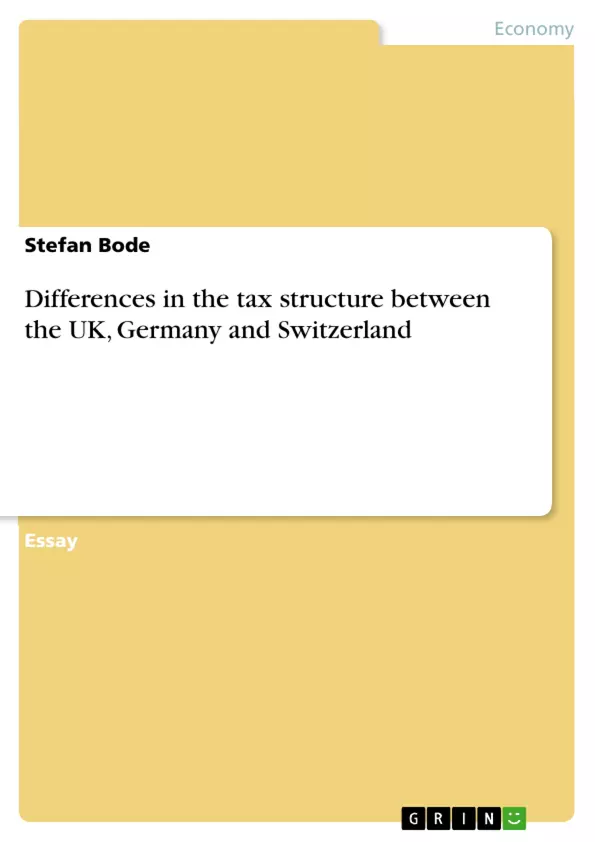This essay provides a short survey of the different tax structures prevailing in the UK, Germany and Switzerland. By doing so, the basic differences and the substantial similarities within and between these three covered countries are presented.
This essay commences by outlining the tax history of Germany and Switzerland. Following, the third section is concerned with the different sources of tax revenue within each above-mentioned country. In the fourth section the focus is channelled to the trends within and between Germany and Switzerland. In this regard, the trends are identified, analysed and finally compared. After outlining the different trends the concentration shifts onto any similarities and differences between and within each country. This essay concludes by summing up the main findings of the different tax structures in the UK, Germany and Switzerland.
Table of Contents
- 1. Introduction
- 2. Background and history of Germany and Switzerland
- 3. Tax structure in the UK, Germany and Switzerland
- 4. Trends within and between Germany and Switzerland
- 5. Similarities and differences within and between the UK, Germany and Switzerland
Objectives and Key Themes
This essay aims to provide a concise overview of the tax structures in the UK, Germany, and Switzerland, highlighting both their differences and similarities. The analysis focuses on the historical development of these systems, their current revenue sources, and prevailing trends.
- Historical development of tax systems in Germany and Switzerland
- Comparison of tax revenue sources across the three countries
- Analysis of current trends in German and Swiss taxation
- Identification of similarities and differences in tax structures
- Overview of the impact of EU regulations on German taxation
Chapter Summaries
1. Introduction: This introductory chapter sets the stage for the essay, outlining its scope and methodology. It briefly previews the topics to be covered, namely, a comparative analysis of the tax systems in the UK, Germany, and Switzerland, focusing on both their commonalities and disparities. The chapter introduces the sequential structure of the essay, promising a historical overview, an examination of current tax structures, an analysis of trends, and a final synthesis of the findings.
2. Background and history of Germany and Switzerland: This chapter delves into the historical evolution of the tax systems in Germany and Switzerland. For Germany, it traces the development from the 19th-century introduction of social security measures under Bismarck to the post-World War II establishment of a high progressive income tax system and the impact of reunification. The influence of the EU on German tax policy, particularly concerning VAT and corporate taxation, is also addressed. For Switzerland, the chapter highlights the significant role of the cantons in shaping the tax landscape and the shift in authority following the formation of the federal state in 1848. The chapter contrasts the centralized nature of the German system with the decentralized approach adopted by Switzerland.
Keywords
UK tax system, German tax system, Swiss tax system, social security contributions, income tax, VAT, corporate tax, EU regulations, tax history, tax trends, fiscal policy, comparative taxation.
Frequently Asked Questions: Comprehensive Language Preview of UK, German, and Swiss Tax Systems
What topics are covered in this language preview?
This preview offers a comprehensive overview of the tax systems in the UK, Germany, and Switzerland. It includes the title, table of contents, objectives and key themes, chapter summaries, and keywords. The focus is on a comparative analysis, highlighting similarities and differences in these systems.
What is the structure of the language preview?
The preview is structured logically, beginning with an introduction, followed by a background on the historical development of the German and Swiss tax systems. It then delves into a comparison of the tax structures in all three countries (UK, Germany, and Switzerland), analyzing trends and identifying similarities and differences. Finally, it concludes with a summary and a list of keywords.
What are the key objectives and themes explored?
The main objective is to provide a concise overview of the tax structures in the UK, Germany, and Switzerland. Key themes include the historical development of these systems, their current revenue sources, prevailing trends, the impact of EU regulations (particularly on German taxation), and a comparison of the centralized (Germany) versus decentralized (Switzerland) approaches to tax administration.
What are the chapter summaries?
The Introduction sets the stage, outlining the scope and methodology. Chapter 2 (Background and history of Germany and Switzerland) explores the historical evolution of German and Swiss tax systems, tracing their development and contrasting their approaches. Further chapters (not fully summarized in this preview) would presumably continue the comparative analysis of tax structures across the three countries.
What keywords describe the content of this language preview?
The keywords include UK tax system, German tax system, Swiss tax system, social security contributions, income tax, VAT, corporate tax, EU regulations, tax history, tax trends, fiscal policy, and comparative taxation.
What is the intended audience for this language preview?
Given its academic nature and focus on structured analysis of themes, the intended audience is likely students or researchers interested in comparative taxation, fiscal policy, or the history of tax systems in the UK, Germany, and Switzerland.
Where can I find more detailed information?
This language preview serves as a concise overview. For a complete and in-depth analysis, consult the full text of the publication from which this preview is derived.
- Citation du texte
- Stefan Bode (Auteur), 2006, Differences in the tax structure between the UK, Germany and Switzerland, Munich, GRIN Verlag, https://www.grin.com/document/66735



